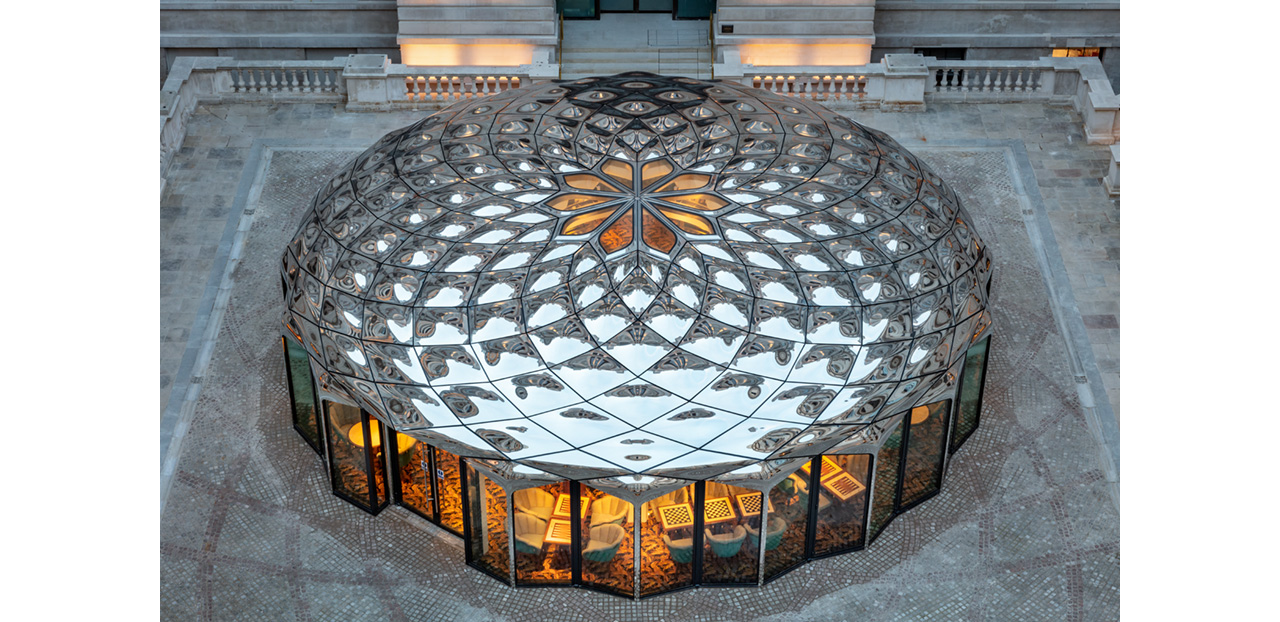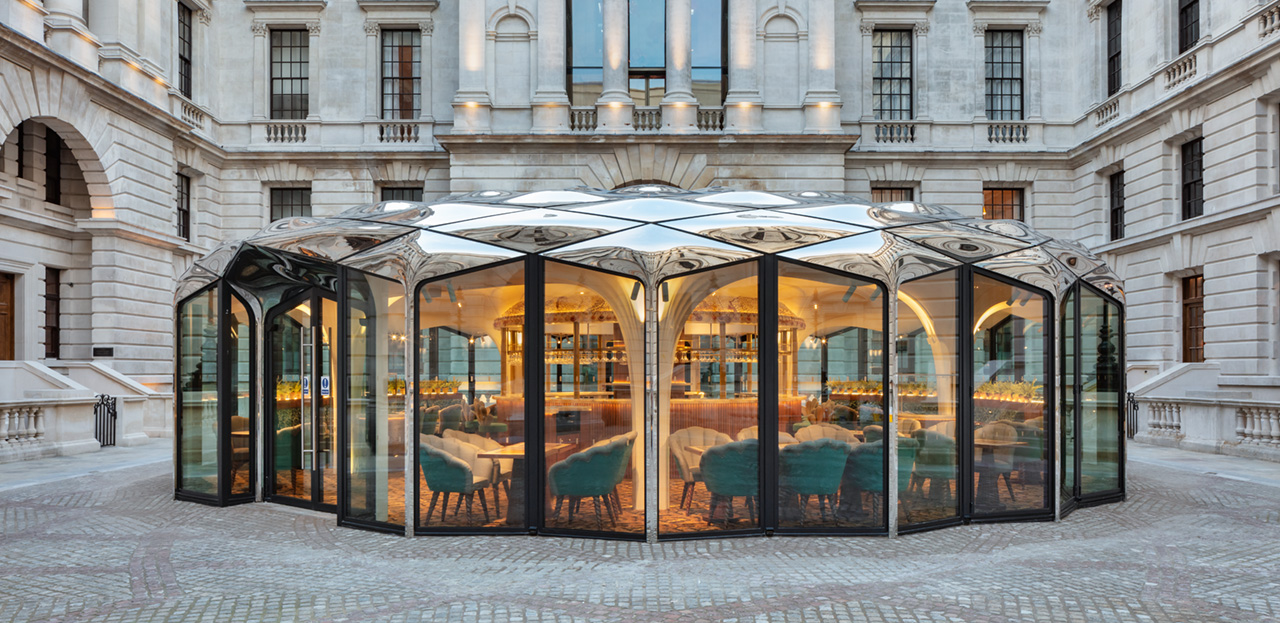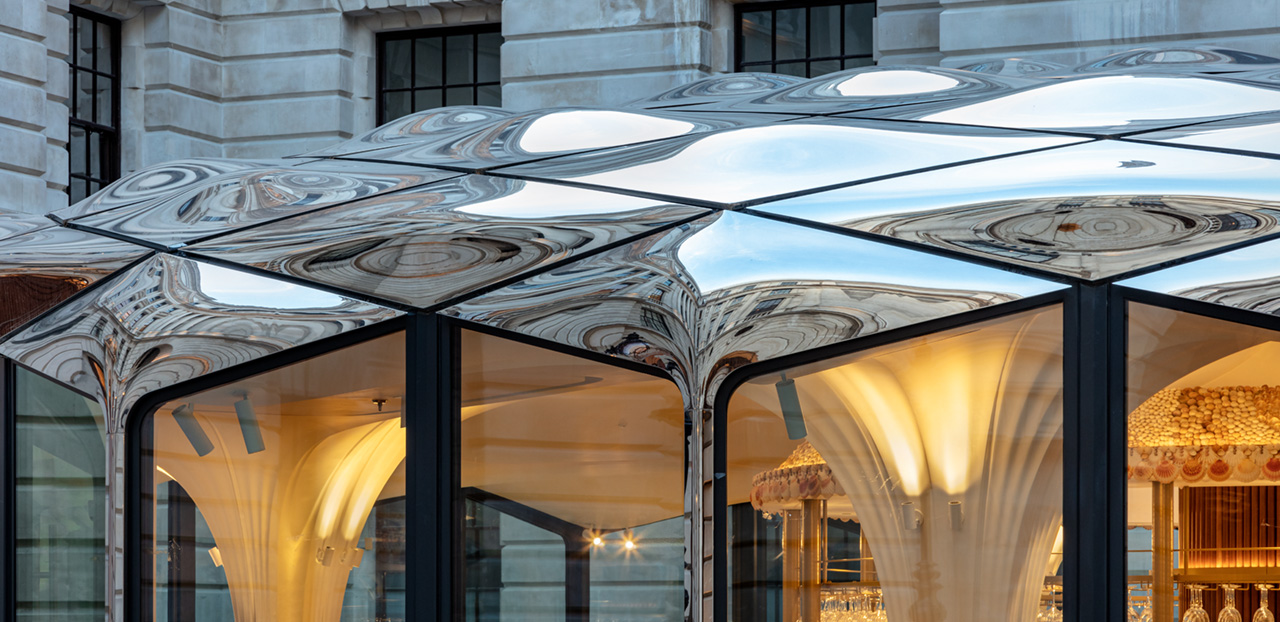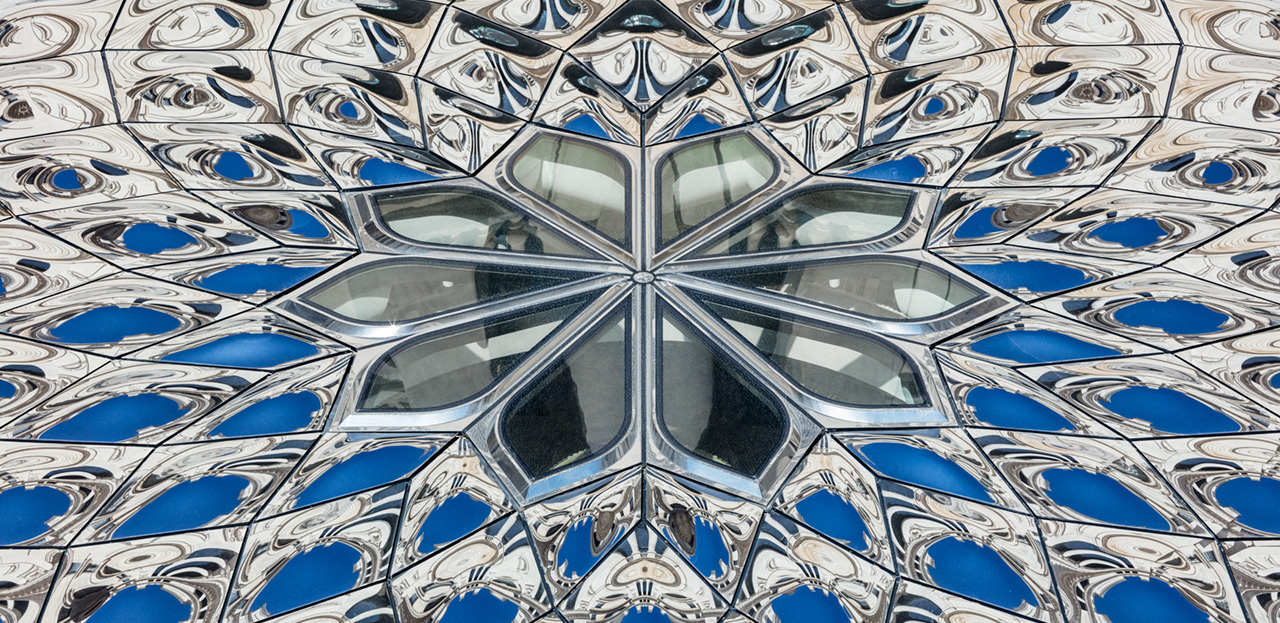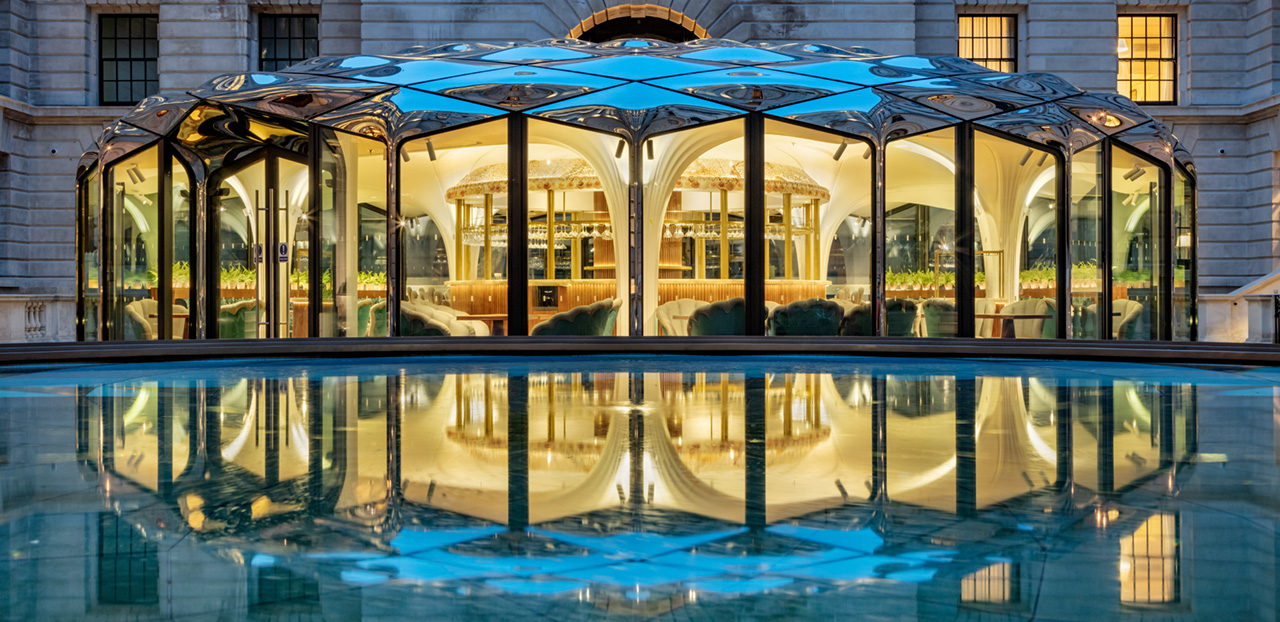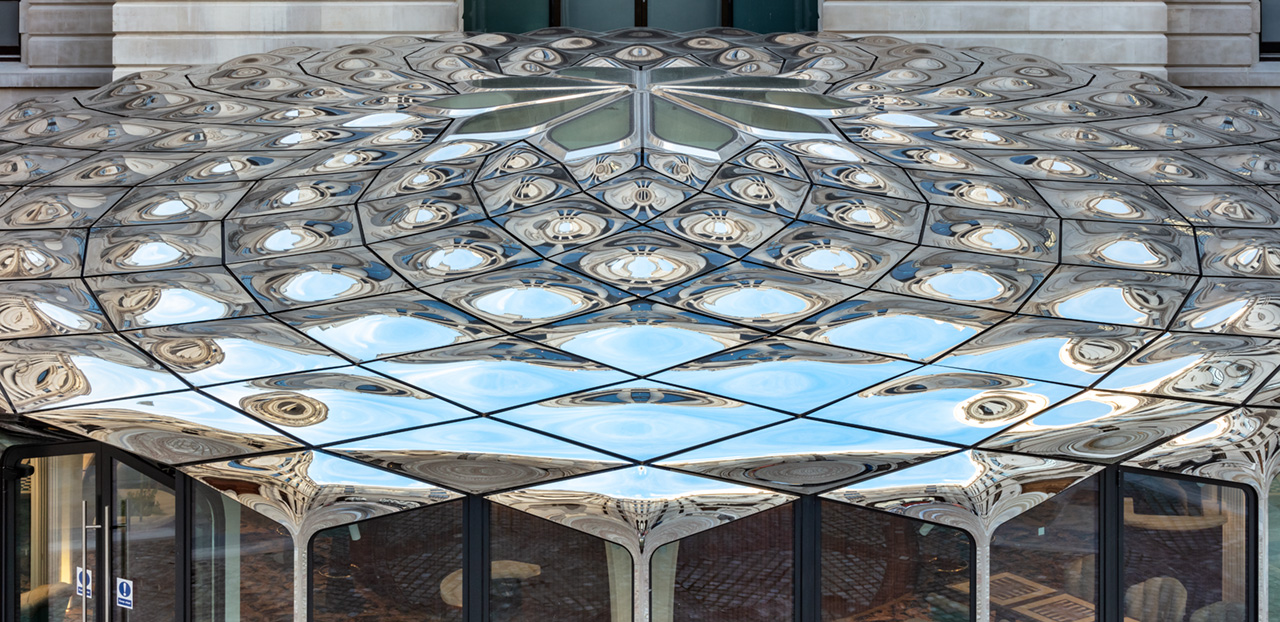The OWO Courtyard Pavilion
A new and contemporary pavilion has been realised in the Grand Courtyard of The OWO, the former Old War Office in Whitehall, London. This pavilion features a poetic design by DaeWha Kang Design. Shiny mirror-polished 3D stainless steel panels on the roof give the pavilion its striking appearance. Octatube translated the highly bespoke design of this pavilion into a technical proposal, and was appointed to engineer and built it.
The Old War Office, a Grade II* listed building in London, has a significant political and historical heritage. But despite its long history, the Old War Office had been vacant for several years. The Neo-Baroque building has now been fully transformed into The OWO, a new destination providing 85 residencies by Raffles, a collection of 9 restaurants and 3 bars, and a 120-room Raffles London hotel. The courtyard pavilion houses the French restaurant Café Lapérouse.
Mathematical geometry
The architect designed the pavilion both as a sculptural object and a building, with deep consideration for its surroundings. On the circular roof of the pavilion 3D shaped mirror-polished stainless steel panels form a mathematical pattern, resembling the pattern found on sunflowers. The rippling form creates a mirage effect, adding lightness and dynamism to the grand historical architecture of the surroundings. The extraordinary geometry has no straight lines and therefor required bespoke solutions and clever craftmanship.
3D fabrication model
During the design phase, we provided technical support and helped the client’s team with the feasibility of the proposed bespoke solutions and the de-risking of the project. We developed a fabrication model based on the architect’s models. We used this model as a communication tool to discuss complex geometric details and interfaces. This allowed the project team to easily visualise the shape of the roof and identify any problems that might arise during fabrication and installation. We refined the challenging geometry without deviating from the design intent. Working in 3D in every step of the process, from the early beginning onward, proved successful.
Mirror-polished 3D panels
Fabricating mirror-polished stainless steel 3D panels is not an easy task, especially when it’s about welding 2mm thick panels. Stainless steel deforms easily when heat is applied. It requires specialised tools and equipment to work with. In addition, scratches or dents on the panels can compromise their visual integrity, making them unsuitable for use.
To develop and deliver the 202 mirror panels, it was crucial to engage with the supply chain to push the boundaries of what is possible. To make panels that accurately reflect the 3D model, we collaborated with two experienced manufacturers in the area. They deployed state-of-the-art manufacturing techniques, including hydraulic 3D pressing, combined with high quality laser cutting and craftmanship as stainless steel welding, hand polishing and structural gluing.
To ensure that the panels remained free of defects, they were carefully protected immediately after pressing and inspected at several points before arriving at the construction site. Once on site, the panels were installed fully protected using specialised detailing and techniques to ensure a tight and secure fit.
Complex vertical stems
Visually, the mirror roof descends into a plinth of 42 vertical ‘stems’ that were complex elements to manufacture. They consist of two pieces, have a challenging geometry and are pre-bent in a welding jig to get and keep them straight.
Transparent façade
The pavilion is composed of five steel columns with arms. Ten curved roof shells are placed on top of this structure, topped by the stainless steel 3D panels. The vertical faces of the façade underneath are made of double-insulated glass panels to meet thermal performance requirements. A gradated mirror treatment is applied at the top and bottom of the glass, allowing the transparent wall to blend seamlessly with the mirror roof. This has a positive impact on the building’s energy performance creates a more transparent middle section of the glass and reduces visual clutter at the floor area. The frames are of darkened stainless steel to contrast with the mirror finish stem panels and roof.
Real-size visual mock up
We created a full-scale visual mock-up (VMU) that brought together various details. We made sure that what we built in the VMU was pre-engineered, so that no changes were needed in the final engineering. We carried out the engineering and the detailed VMU simultaneously, within the short time frame of four months, working out the engineering in the smallest details.
Skylight
In the centre of the pavilion, a custom-made skylight allows in daylight. We made its steel frame with very bespoke detailing to the millimetre. The unusual shapes required manual work in welding and polishing. It was hoisted into the roof structure in one hoist and fitted perfectly.
Precision alignment
One of the key challenges in building a 3D-formed rainscreen roof is ensuring that the panels are properly aligned and joined together. Any misalignment or gap compromises the installation and visual integrity of the design. Our engineering and construction teams worked closely during the design phase to develop the detailing. High precision, attention to detail, and the use of tailor-made templates and fixtures helped ensure the panels were perfectly aligned during installation.
Close interplay
Designing and building a 3D-shaped stainless steel roof is complex and challenging, requires a high degree of skill, expertise and attention to detail. However, the result is stunning and a true eye-catcher: the light and the mirrors of polished steel create a dynamic and ever-changing visual experience. The durability and longevity of the material ensure that the roof will stand the test of time.
We realised this remarkable pavilion in close interplay with the architect DaeWha Kang Design, Arup, Fielitz and others. All in covid-times, where meeting in person was not possible.
Instagram @theowo.london
Photographed by Kyungsub Shin

